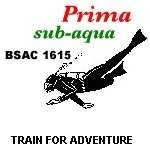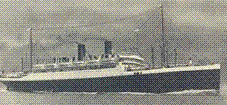
Issue 4 March 2007
Off-Gassing...
(Web Version)
Welcome to the fourth issue of our newsletter.
Don’t forget the DIVERS FORUM, Tuesday the 3rd
April 2007 at the Woodman Pub. A raffle ticket for everyone that
attends, chance to win a mystery prize.
Congratulations to proud parents Angela & Mark. Ryan was born at 12.45
am, Thursday morning weighing 10.1lb. He looks just like his Dad
Profile:- Chris Bennett - Training Officer
10th March
NDAC Chepstow ___________
17th March
Boat Familarization
More Info: See Roy. ___________
Sophie’s 21st at was well attended at Wing Wah on the 2nd March 2007.
Fay passed her exams and jetted off to Arizona for her months of flying instruction.
Phil our Diving Officer will celebrate his 40th on 27th March 2007.
I have been diving with Prima for about 9 years and have now become an advanced diver but my first taste of scuba diving was out in Turkey on my holidays, I did the standard suck and see try dive which led me to doing a day trip with the dive school out in the bay at Marmaris which was really amazing.

I have been to many dive sites, the first in this country was good old Stony Cove, then Abersoch my first sea dive and first wreck(age) all in one weekend after that I wanted more so off I went to Criccieth, Anglesey, Scapa flow, Red sea, Mull and Skye, the south coast and good old Dosthill on sea. Some of the best dives I have ever done were in the Farnes, from the rib, swimming with seals and wreck diving, what more do you need? Oh, I forgot beer and lots of it.
Many dives have past in the last 9 years, some good, some really shit but one thing I can say, “I have enjoyed every minute”.
Cock ups I got the brass ass for saying orgasms instead of organism when giving a lecture.
Advice: Dive the way you want to, then go to the pub and order real ale not cooking lager as it tastes better
SOLENT WRECK WEEKEND - 25th-28th May.
10 litre Cylinder. In test
£50 contact: Richard Mace
0121 232 6007
If you have any items for sale please let us know.
Diving in tidal water can be
challenging sometimes, however the Solent ups the ante by having up to 4
tidal cycles a day, making dive planning a great deal harder and tidal
currents a bit more interesting. The areas naval history means a lot of
wrecks, especially from WW2. Based in Portsmouth at Port Solent, we will
be diving the east coast of the Isle of Wight,
passing through Portsmouth naval docks each day so we can see the
warships and the Mary Rose. The trip will be a good chance to get on
some 30-35m big wrecks and some scenic splashes for 2nd dives. One
definite dive site I'm planning is the wreck of the U-1195 - a German
U-boat famous for sinking the James Egan Layne. Other sites in mind
include RMS Mendi, HMS P-12, Cuba, NAB Tower, Solent Fort and a tank
landing craft.

The Cuba: See Wreck of the month.
Wreck of the Month. The Cuba
Editors Corner
Thank you to everyone who has contributed to this months issue, and
apologies for any mistakes.
Any further articles for next months edition would be appreciated, (any gossip, scandals, etc that’s printable) so let us know by 20th April.
Hope you enjoyed this issue.
The Cuba is a two-funnel passenger liner at 476ft long with a beam of 62ft she was a large ship. Her engines delivered 10,300hp and could push her 11,500tons through the water at 15.5knots.
In 1940 she was intercepted by a British warship and enlisted for wartime duties as a troopship. It was these duties she was carrying out when sunk by a torpedo on 6th April 1945. As part of a convey returning home to Southampton from Le Harve she had over 260 troops on board. Despite being lead by 6 destroyers when Kapitänleutnant Ernst Cordes of the German U-boat U-1195 saw her in his periscope he couldn’t let her pass. At 4.13am a single torpedo from the U-1195 hit the Cuba killing one member of crew but doing enough damage to sink the ship. The Cuba slowly settled upright and stayed this way allowing all members of crew to escape unharmed. This was the 2nd big kill for the U-1195 in a fortnight as 10 days previous it had sank the much-loved James Egan Layne.
Today, the Cuba sits on a 32m deep seabed. Despite much salvage work being carried out by the Navy some of the wreck stands 14m proud of the seabed with some large intact recognisable sections. The site is quite dispersed with deck plating and girders scattered over a large area. As the Cuba was a luxury liner in her time, she has over 200 portholes, most of which are still there, hidden amongst the wreckage. Overall this should be a good rummage dive over a large site, similar to the Somali but bigger.
Dugongs